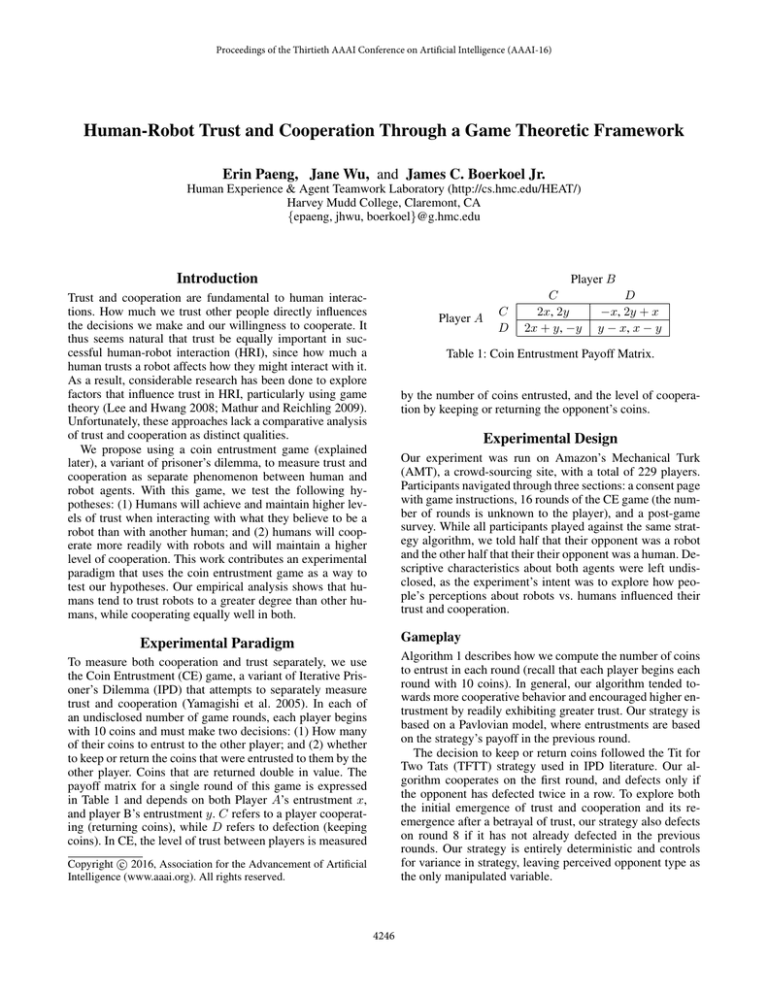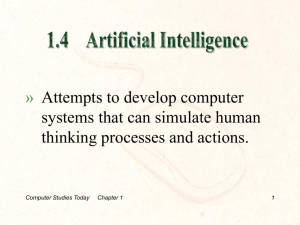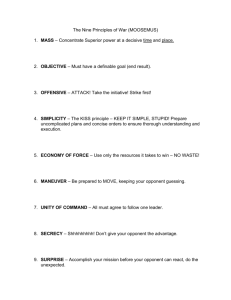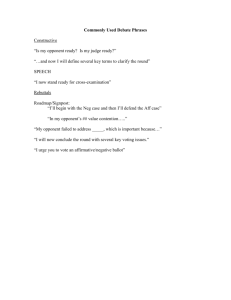
Proceedings of the Thirtieth AAAI Conference on Artificial Intelligence (AAAI-16)
Human-Robot Trust and Cooperation Through a Game Theoretic Framework
Erin Paeng, Jane Wu, and James C. Boerkoel Jr.
Human Experience & Agent Teamwork Laboratory (http://cs.hmc.edu/HEAT/)
Harvey Mudd College, Claremont, CA
{epaeng, jhwu, boerkoel}@g.hmc.edu
Introduction
Trust and cooperation are fundamental to human interactions. How much we trust other people directly influences
the decisions we make and our willingness to cooperate. It
thus seems natural that trust be equally important in successful human-robot interaction (HRI), since how much a
human trusts a robot affects how they might interact with it.
As a result, considerable research has been done to explore
factors that influence trust in HRI, particularly using game
theory (Lee and Hwang 2008; Mathur and Reichling 2009).
Unfortunately, these approaches lack a comparative analysis
of trust and cooperation as distinct qualities.
We propose using a coin entrustment game (explained
later), a variant of prisoner’s dilemma, to measure trust and
cooperation as separate phenomenon between human and
robot agents. With this game, we test the following hypotheses: (1) Humans will achieve and maintain higher levels of trust when interacting with what they believe to be a
robot than with another human; and (2) humans will cooperate more readily with robots and will maintain a higher
level of cooperation. This work contributes an experimental
paradigm that uses the coin entrustment game as a way to
test our hypotheses. Our empirical analysis shows that humans tend to trust robots to a greater degree than other humans, while cooperating equally well in both.
Player A
C
D
Player B
C
D
2x, 2y
−x, 2y + x
2x + y, −y y − x, x − y
Table 1: Coin Entrustment Payoff Matrix.
by the number of coins entrusted, and the level of cooperation by keeping or returning the opponent’s coins.
Experimental Design
Our experiment was run on Amazon’s Mechanical Turk
(AMT), a crowd-sourcing site, with a total of 229 players.
Participants navigated through three sections: a consent page
with game instructions, 16 rounds of the CE game (the number of rounds is unknown to the player), and a post-game
survey. While all participants played against the same strategy algorithm, we told half that their opponent was a robot
and the other half that their their opponent was a human. Descriptive characteristics about both agents were left undisclosed, as the experiment’s intent was to explore how people’s perceptions about robots vs. humans influenced their
trust and cooperation.
Gameplay
Experimental Paradigm
Algorithm 1 describes how we compute the number of coins
to entrust in each round (recall that each player begins each
round with 10 coins). In general, our algorithm tended towards more cooperative behavior and encouraged higher entrustment by readily exhibiting greater trust. Our strategy is
based on a Pavlovian model, where entrustments are based
on the strategy’s payoff in the previous round.
The decision to keep or return coins followed the Tit for
Two Tats (TFTT) strategy used in IPD literature. Our algorithm cooperates on the first round, and defects only if
the opponent has defected twice in a row. To explore both
the initial emergence of trust and cooperation and its reemergence after a betrayal of trust, our strategy also defects
on round 8 if it has not already defected in the previous
rounds. Our strategy is entirely deterministic and controls
for variance in strategy, leaving perceived opponent type as
the only manipulated variable.
To measure both cooperation and trust separately, we use
the Coin Entrustment (CE) game, a variant of Iterative Prisoner’s Dilemma (IPD) that attempts to separately measure
trust and cooperation (Yamagishi et al. 2005). In each of
an undisclosed number of game rounds, each player begins
with 10 coins and must make two decisions: (1) How many
of their coins to entrust to the other player; and (2) whether
to keep or return the coins that were entrusted to them by the
other player. Coins that are returned double in value. The
payoff matrix for a single round of this game is expressed
in Table 1 and depends on both Player A’s entrustment x,
and player B’s entrustment y. C refers to a player cooperating (returning coins), while D refers to defection (keeping
coins). In CE, the level of trust between players is measured
c 2016, Association for the Advancement of Artificial
Copyright Intelligence (www.aaai.org). All rights reserved.
4246
Algorithm 1: Coin Entrustment
Input :
PREVIOUS PAYOFF, the total number of coins
won in the previous round. ENTRUSTMENT, the
number of coins entrusted by our opponent in
the previous round.
Output: The number of coins to entrust
if first round then
entrust 3
else
if either player defected in the previous round then
entrust 1
else
ENTRUSTMENT = 10+( PREVIOUS PAYOFF-10)/1.5
entrust min(ENTRUSTMENT, 10)
Figure 1: Average entrustment (measured in the number of
coins entrusted) per round.
perceptions about robots and humans. Participants perceive
that humans posess greater intelligence, rationality, sympathy, humanity, faculty for feelings and sensations, and life,
while robots are more perfect, precise, and reliable.
Post-game survey
After the game concluded, we presented participants with
a survey that asked: (1) What motivated participants when
playing the game (to assess whether people who played
against robot vs. human opponents were differently motivated)?, (2) Do qualities attributed to humans and robot differ? (Arras and Cerqui 2000), and (3) How does participants’ trust in robots compare to their trust in humans? (Jian,
Bisantz, and Drury 2000). The survey was presented twice to
each participant, addressing perceptions about humans and
robots separately. A participant that played against a robot
first answered questions about robots, then were asked to
imagine a game involving the a human opponent and answer
the same questions (and vice versa).
Discussion
In this paper, we explored how people trust and cooperate with robots differently than they do with humans using
a game-theoretic framework. Our experiment confirms that
people develop trust faster and to a greater extent with robots
than they do with humans in this particular game scenario.
In the future, we would like to extend our explorations to a
wider variety of interaction domains. We would also like to
develop a deeper understanding of why such trends emerge.
For instance, participants who played against a robot report
coin maximization as their primary motivator, while those
who played against a human were primarily motivated by
victory over their opponent. This points to a possible dynamic in inter-personal relationships that is missing from
human-robot interactions—the desire for social dominance.
Summary of Results
We collected results along three dimensions: trust—the
number of coins entrusted per round; cooperation rate—
the rate at which players choose to return, rather than keep,
their opponent’s coins; and qualitative perceptions about the
opponent—measured by our post-game survey. In Figure 1,
we see how a participant’s trust in their opponent progresses
through the game. We used a mixed ANOVA to evaluate our
results, with the between-subjects factor being the opponent
type and the within-subjects factor being the 16 rounds. Our
ANOVA confirms that opponent type leads to statistically
significant differences in coins entrusted across all rounds,
with F (15, 3405) = 1.804, p < .05. Therefore, we confirm our first hypothesis that players trust robots more than
humans in across the rounds. This difference is particularly
acute after defection occurs in round 8—humans tended to
regain trust in their robot opponents, but not human opponents. We also measured the cooperation rate per round,
which we calculate as the cumulative ratio with which the
participant cooperated versus defected. We found that participants cooperated at nearly identical rates regardless of
opponent type, indicating people tended to adjust the number of coins they entrust rather than punish their opponent by
keeping their coins. We were thus unable to reject the null
hypothesis for our second hypothesis.
Our post-game survey highlighted differences in people’s
References
Arras, K., and Cerqui, D. 2000. Do we want to share our
lives and bodies with robots. A 2000-people survey, Technical Report Nr. 0605-001 Autonomous Systems Lab Swiss
Federal Institute of Technology.
Jian, J.-Y.; Bisantz, A. M.; and Drury, C. G. 2000. Foundations for an empirically determined scale of trust in automated systems. Int’l J. of Cognitive Ergonomics 4(1):53–71.
Lee, K. W., and Hwang, J.-H. 2008. Human–robot interaction as a cooperative game. In Trends in Intelligent Systems
and Computer Engineering. 91–103.
Mathur, M. B., and Reichling, D. B. 2009. An uncanny
game of trust: social trustworthiness of robots inferred from
subtle anthropomorphic facial cues. In Proc. of HRI-2009,
313–314.
Yamagishi, T.; Kanazawa, S.; Mashima, R.; and Terai, S.
2005. Separating trust from cooperation in a dynamic relationship prisoner’s dilemma with variable dependence. Rationality and Society 17(3):275–308.
4247



